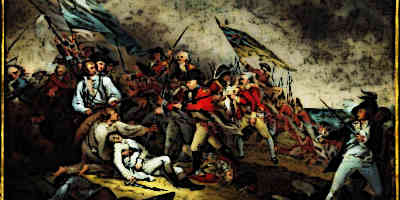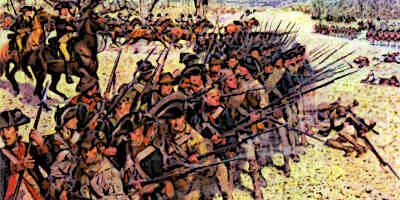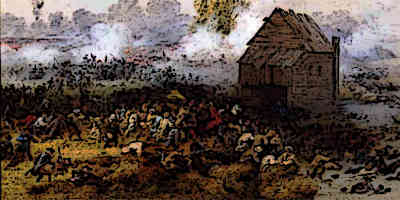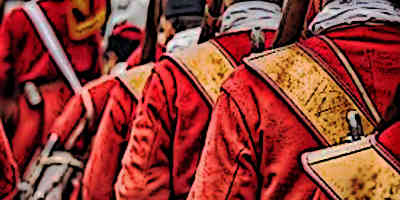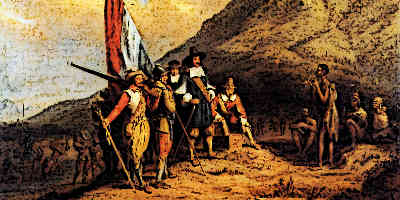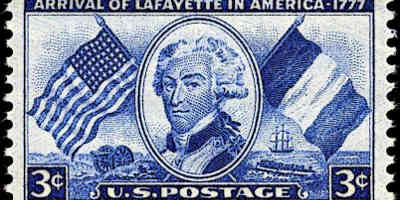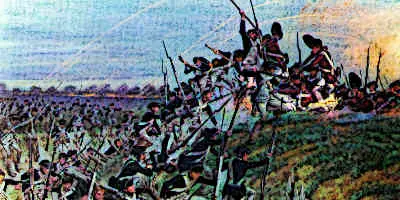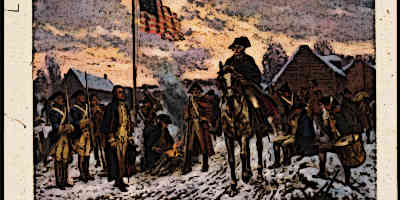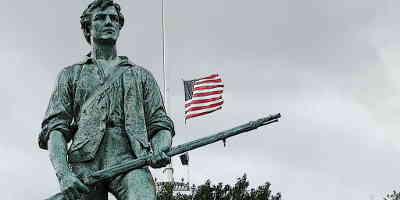Battle of Bunker Hill
The Battle of Bunker Hill took place between the British and American forces near Boston in 1775
Battle of Cowpens
The Revolutionary War broke out between the American colonies and Britain in 1775
Battle of Freeman’s Farm (1777)
The Battle of Freemans Farm in 1777 was an important battle in the revolutionary war.
Battle of Guilford
The Battle of Guilford Courthouse during the American Revolutionary War, took place at in North Carolina
Battle of Long Island
On August 27, 1776, the Battle of Long Island began. The British army initiated the fighting by sending a group...
British Capture Philadelphia (1777)
In 1777 The British Captured Philadelphia under British General William Howe in their ongoing battles against American Independence...
British Capture Savannah (1778)
The British Captured Savannah in 1778, against the Americans led by Lieutenant Colonel Campbell
Dutch Join the American Revolution (1780)
The Dutch were only able to help in terms of trading and offering important supplies during the War of Independence
Marquis de Lafayette
Marquis de Lafayette was renowned for his role in the American Revolutionary War
Siege of Yorktown
The British forces were heavily defeated in the Siege of Yorktown by the American army
Spain Enters the American Revolution (1779)
Spain Joins America - Spain openly declared war against Britain and announced that it was siding with the Americans
The Battle of Valley Forge
When the American Army reached Valley Forge in 1777, they weren't well-trained or well organized
The Minutemen of the American Revolution
Minutemen were American colonists who formed militias to fight off their enemies at a 'minutes notice'.
Washington’s Crossing of the Delaware (1776
The American Army under George Washington crossed the Delaware River to attack British enemy forces
Following are some of the key battles that took place during the Revolutionary War:
Battles of Lexington and Concord
Although these were minor battles, they were the first open fight between British soldiers and colonial militias. It was in these battles that the first shots of the war were fired. For this reason, these two battles carry immense historical significance. Both battles were fought in Middlesex County, Massachusetts. Although both sides suffered few casualties, the British were forced to withdraw from open area to the safety of Charlestown.
Battle of Fort Ticonderoga
The Battle of Fort Ticonderoga took place in May, 1775. It was one of the earlier showdowns between American colonial militias and the British troops.
It took place around Fort Ticonderoga in Essex County, New York. The fort was considered important for many reasons. It oversaw the waterway that connected Northern provinces with the Thirteen Colonies. It was also home to a large body of ammunition, cannons and other artillery equipment. A small force of militiamen took the British soldiers at the fort by surprise and forced them to surrender. The large body of armament captured at the fort was immensely helpful in the subsequent battles.
Battle of Bunker Hill
The Battle of Bunker Hill was one of the early battles fought in the war. It took place on June 17, 1775 in Charlestown, Massachusetts. In this battle, the British gained victory after sustaining very heavy losses. The battle was fought over the control of the Bunker Hill and Breed’s Hill near Charlestown.
The American militia forces took possession of the hills. The British then attacked the hills in order to remove the colonial forces. The frontal British attacks were very costly and the total British casualties were above 1,000 from a force of 3,000 troops.
Battle of Quebec
The Battle of Quebec was fought during the attempts of American forces to take the control of Canadian territories from British troops. It was fought in December, 1775 in the modern-day Quebec City. The American militia forces had already captured Montreal and decided to attack Quebec.
The attack took place in a snowstorm during which the troops could not effectively coordinate. Ultimately, the attack failed when General Richard Montgomery, who was leading one group of American soldiers, was killed. The British forces were successful and more than 400 American troops were taken as prisoner. With this defeat, the American plans of conquering Canada effectively came to an end.
Battle of Long Island
The Battle of Long Island was fought on August 27, 1776. It was the first major battle of the war and was fought over the control of New York. At the time, the city of New York was under the control of the Continental Army under George Washington. The city had a very important harbor, so the British wanted to take it and use the harbor. So they launched an attack on the American forces from the front and rear. The American forces panicked and fled, resulting in a decisive British victory.
Battle of White Plains
The Battle of White Plains was fought in October, 1776. It was fought as a part of the series of battles that took place in New York and New Jersey during the Revolutionary War. The battle took place at White Plains in New York. At the time, the Continental Army under George Washington had just been defeated and was retreating.
British forces under General Howe decided to pursue Washington’s army. The American army camped at White Plains but the British forces caught up soon and forced further retreat of the American forces. The battle was a British victory although the British also incurred more losses on their side.
Battle of Fort Washington
The Battle of Fort Washington was one of the worst defeats of the American forces. It was an early battle of the war, fought on November 16, 1776. The battle was fought primarily over the control of Fort Washington located at Washington Heights, Manhattan.
A British army under Lieutenant General William Howe attacked the fort from three sides. On the American side, important commanders include George Washington and Nathanial Greene. After stiff resistance, the American troops were defeated and the fort was run over by British forces. The British were victorious and took nearly 3,000 American soldiers as captives.
Battle of Trenton
The Battle of Trenton was a very important battle fought on December 26, 1776. It was fought at a time when the Continental Army under George Washington had suffered many setbacks. The morale of the army was low and many began to think that Americans could not win the war.
Washington decided to steal a march on the Hessian mercenaries stationed in Delaware. A small colonial army crossed the Delaware River at night and was able to surround the Hessians. The Hessians surrendered after a brief fight. The victory suddenly boasted the morale of the Americans and reignited their hopes of winning the war.
Battle of Princeton
The Battle of Princeton was fought in January, 1777. It took place in Princeton, New Jersey. At the time, the morale of the American troops was low. George Washington wanted to raise the morale by leading the Continental Army to a few victories before stopping the fighting for the winter.
He decided to attack the British troops garrisoned in Princeton. His attack was successful and he was able to take nearly 300 British troops as prisoners. American troops under Washington also fought with two regiments of the British army, forcing the British to retreat. These victories boosted the morale of the Continental soldiers and restored hope among the revolutionaries.
Battle of Brandywine
The Battle of Brandywine was the largest battle of the Revolutionary War in terms of the number of troops who fought in it. It was also the longest single-day battle where both sides fought for 11 continuous hours. The battle was fought on September 11, 1777. Nearly 15,000 troops fought on either side. The battle was a part of the British campaign to capture Philadelphia. It resulted in an important British victory which eventually led to the capture of the city two weeks later.
Battles of Saratoga
The Battles of Saratoga were two battles that were fought on September 19 and October 7, 1777. Both battles took place in Saratoga County, New York. The British were victorious in one of the battles but sustained heavy losses. In the second battle, the British army was defeated and surrounded. It was forced to surrender, significantly weakening the British side. The surrender of the British army also encourage the French to begin attempts for forming an alliance with the Americans.
Battle of Germantown
The Battle of Germantown was fought in Germantown, Pennsylvania. It took place on October 4, 1777. The British army under General Howe had recently defeated the Continental Army and now camped at Germantown. George Washington, leading the Continental Army, decided to engage the British forces.
He divided the army into four columns who were to advance towards British base in Germantown. The plan was foiled by foggy conditions which created a lack of coordination between militia groups. Ultimately, the British were able to repulse the attack successfully, inflicting heavy losses on the Americans.
Battle of Monmouth
The Battle of Monmouth took place in June, 1778. It was the first major battle fought by the Continental Army after its rigorous training at the Valley Forge. The battle took place as the Continental Army decided to attack the rear of the retreating British army.
The initial attack of the Continental Army was unsuccessful and British forces under General Cornwallis attacked the American troops in turn. The American troops rallied under George Washington. Although they were pushed back a little, they were able to hold their ground and stopped the British advance. Before any side could claim a decisive victory, the day ended and the battle was considered a draw.
Siege of Savannah
The Siege of Savannah took place as a part of American attempts to retake the city of Savannah during the Revolutionary War. The British had taken control of the city in 1778. The next year, American troops and allied French colonial recruits decided to retake the city. They launched an attack on the city but the attack was repulsed with heavy losses. The French naval vessels which were meant to assist in the attack were blockaded by the British vessels. Ultimately, the siege resulted in heavy losses for the American forces, resulting in nearly 800 casualties.
Siege of Charleston
The Siege of Charleston took place from March to May, 1780. The city was besieged by British forces, starting in March. Thousands of American militiamen were trapped inside the city under the leadership of Major General Benjamin Franklin. After months of siege, the British were able to advance very close to the city and Franklin saw no option but to surrender. This was the largest American surrender until the Civil War. More than 3,000 American soldiers surrendered and the British gained a decisive victory. However, the British were unable to gain momentum in the South despite this major victory.
Battle of Kings Mountain
The Battle of Kings Mountain took place in October, 1780. It was fought between Patriot militias supporting the American Revolution and the Loyalist militias supporting the British cause. The Loyalist forces were led by British Major Patrick Ferguson. Although both sides numbered below 1500, the battle was notable because both sides comprised of Americans. The battle resulted in a decisive victory for the Patriot forces. Ferguson was fatally shot and died. This wrecked the British plans of capturing North Carolina and gave the revolutionaries in the South a morale boost.
Battle of the Chesapeake
The Battle of the Chesapeake took place in September, 1781. It was a naval engagement between the French and British forces. The French were allied with the Americans in the war and prevented the British Royal Navy from relieving the besieged British army in Yorktown. The battle was a decisive French victory which contributed to the surrender at Yorktown and consequently, to the end of the war.
Battle of Guilford Court House
The Battle of Guilford Court House was fought on March 15, 1781. It was a pyrrhic British victory. Although the British army comprised of only about 2,100 men, it was able to defeat a 4500-strong American army. However, the casualties on the British side were heavy. The British army that fought in this battle was meant to take control of the southern states. But with such heavy losses, the army was weakened and wasn’t able to achieve that objective eventually.
Battle of Cowpens
The Battle of Cowpens was fought on 17 January, 1781. It took place in Cherokee County near the area of Cowpens in South Carolina. The British forces had previously conquered most of South Carolina. The battle was fought as a part of the American attempts to regain control of the state. It resulted in a decisive American victory. With this victory, the American forces effectively started the reconquest of South Carolina.
Battle of Yorktown
The Battle of Yorktown led to the most important American victory in the war. It was fought at Yorktown, Virginia from September 28, 1781 to October 19, 1781. At the time, around 9,000 British troops were stationed at Yorktown under the leadership of General Cornwallis. Nearly 19,000 combined American and French troops laid siege to the British army. A British fleet coming to the aid of British troops was defeated. After a protracted siege, the British were forced to surrender. More than 7,000 British soldiers were captured. This finally forced Great Britain to start negotiations for peace with United States.

